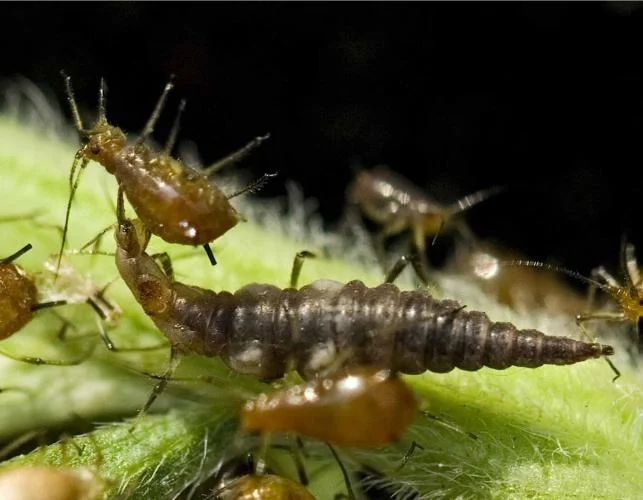Beneficial Insects In Organic Gardening: Allies In Pest Control
Beneficial insects are insects that provide ecological services like pollination and pest control. They play an important role in organic gardening by helping to naturally control pest populations without the use of chemical pesticides. Some of the most common beneficial insects include ladybugs, lacewings, parasitic wasps, hoverflies, and predatory mites.
In organic gardening, beneficial insects are a key component of integrated pest management (IPM), which aims to control pests through a combination of biological, cultural, physical and chemical tactics that minimize risks. Since synthetic pesticides are prohibited, beneficial insects serve as a natural way to keep pest insects like aphids, caterpillars and spider mites under control.
This article will provide an overview of some of the most important beneficial insect species for organic garden pest control. It will explain what they eat, how they help control pests, and tips for attracting them to your garden.
Ladybugs
Ladybugs, also known as lady beetles or ladybird beetles, are a common beneficial insect found in many gardens. They are small, round beetles that are typically red or yellow with black spots. There are over 450 species of ladybugs in North America alone.
Ladybugs are voracious predators, especially in their larval stage. The larvae resemble tiny alligators and eat soft-bodied insect eggs and juveniles such as aphids, mealybugs, spider mites, and scale insects. Adult ladybugs also eat these pests but consume fewer overall than the larvae.
A single ladybug larva can eat over 400 aphids in its development, while an adult ladybug may eat up to 75 aphids per day but only lives for a few months. By releasing ladybugs in your garden, both the larvae and adults will help control soft-bodied pests and prevent them from destroying your plants.
In addition to aphids, mealybugs, spider mites and scale, ladybugs also feed on mites, whiteflies, and other small insects. They are an excellent natural pest control for organic gardens and greenhouses where the use of chemical insecticides needs to be avoided.
Attracting and maintaining a healthy ladybug population can dramatically reduce the need for other pest control methods. Their voracious appetites make them a gardener’s best friend when it comes to controlling pest outbreaks.
Lacewings
Lacewings are a family of insects known as Neuroptera that are beneficial predators in organic gardens. There are several species of lacewings, but the most common are green lacewings (Chrysoperla rufilabris) and brown lacewings (Hemerbius spp.). Lacewings have long, delicate, pale green or brown wings with complex venation.
Lacewings undergo complete metamorphosis with four life stages – egg, larva, pupa, and adult. The eggs are laid at the end of long stalks which helps protect them from predators. The larvae are known as “aphid lions” because they are ferocious predators that actively hunt soft-bodied insects like aphids, mealybugs, thrips, and mites. Lacewing larvae have large, hollow, sickle-shaped mandibles that pierce prey and suck out the fluids [1]. Each lacewing larvae can consume 100 or more pests per week.
Adult lacewings are not predaceous like the larvae and eat pollen, nectar, and honeydew. By releasing lacewing eggs or larvae at the first signs of pests, gardeners can harness the voracious appetites of the larvae to naturally control pest populations.

Ground Beetles
Ground beetles are a large family of predatory beetles found commonly in agricultural settings. There are several thousand species worldwide with around 2,000 species in North America alone 1. They are distinguished by their oval or elongate shape and ridged wing covers (elytra). Ground beetles prey on a variety of garden pests including slugs, snails, cutworms, root maggots, cabbage worms, corn earworms, vine borers, and the eggs and larvae of other insects 2.
Some common species found in North America include:
- Black ground beetle (Pterostichus niger) – a shiny black beetle about 0.5 inches long that eats caterpillars and other soft-bodied insects.
- Green ground beetle (Elaphrus viridis) – a bright iridescent green beetle that consumes slugs and snails.
- Fiery searcher (Scarites subterraneus) – a fast-moving beetle with large jaws that prey on insects, snails, and plant roots.
- Caterpillar hunter (Calosoma scrutator) – a brightly colored beetle that eats gypsy moth larvae.
Ground beetles are voracious predators, both as adults and larvae. They hunt at night and hide under rocks, boards, leaf litter or in the soil during the day. By promoting habitat for ground beetles through reduced tilling and preservation of soil litter, gardeners can enlist their help as an organic method of pest control.
Parasitic Wasps
Parasitic wasps are a common beneficial insect found in gardens. They are natural predators that help control pest populations. Adult wasps lay their eggs inside or on the bodies of other insects, including common garden pests like aphids, caterpillars, beetle larvae, flies, and thrips. The wasp eggs hatch and the larvae feed on and ultimately kill their host insect (https://podhya.com/category/how-to-guides/pest-disease-control/).
There are thousands of species of parasitic wasps, but some of the most common in gardens are braconid wasps, ichneumon wasps, chalcid wasps, and trichogramma wasps. They range in size from just a millimeter long to several centimeters. Most species are black or brown in color. Parasitic wasps have specialized ovipositors at the tip of their abdomens that allow them to lay eggs in or on other insects.
The life cycle starts when an adult female wasp finds a suitable host insect to parasitize. She lays an egg on or inside the host’s body and flies away. The wasp egg hatches and the larva begins feeding on the host while it is still alive. After killing and consuming the host from within, the wasp larva pupates, then emerges as an adult wasp ready to repeat the cycle (https://podhya.com/8-organic-gardening-tips-podhya/).
By parasitizing and killing common garden pests, parasitic wasps provide natural biocontrol and are an important component of integrated pest management in organic gardening.
Hoverflies
Hoverflies (Syrphidae) are a family of true flies that mimic the appearance of bees and wasps, but are completely harmless (Frontiersin.org, 2023). The larvae of many hoverfly species are predators that feed voraciously on common garden pests like aphids, thrips, and small caterpillars. Their larvae have soft, elongated, somewhat maggot-like bodies and can consume hundreds of pests during their development stage (Entomology.ces.ncsu.edu, n.d.).
In addition to natural pest control benefits, hoverflies are also important pollinators. The adults frequently visit flowers to drink nectar, inadvertently transferring pollen between blossoms. Studies show that some species like Eupeodes corollae provide substantial pollination services, comparable to bees (Frontiersin.org, 2023).
By attracting hoverflies to gardens, organic growers can harness their biocontrol and pollination abilities for reduced pest damage and greater yields.
Praying Mantises
Praying mantises are formidable predators that hunt and eat other insects. They have elongated bodies, triangular heads, large compound eyes, and spiny raptorial forelegs designed for grasping and holding prey. Their common name comes from their distinctive upright posture with front legs folded as if in prayer.
Praying mantises are generalist predators that consume a wide variety of pests including aphids, caterpillars, flies, crickets, beetles, and moths. They patiently wait motionless with front legs upraised to snatch unwary insects lured within their reach. Lightning fast movements allow them to grasp prey with their spiny forelegs. They will eat any insect or arachnid they can safely overpower and hold.
The camouflage coloring of praying mantises allows them to blend into foliage, disguising them from potential prey. Their compound eyes enable detailed stereoscopic vision to judge distances accurately when striking. Some species also exhibit deimatic displays, suddenly revealing bright colors or eyespots to startle an intruder. Praying mantises bring formidable predatory skills to the garden ecosystem.
Predatory Mites
Predatory mites are tiny arachnids that feed on the eggs, larvae, and adults of pests like spider mites, thrips and chinch bugs. There are many different species of predatory mites that can help control pests in an organic garden.
Some common types of predatory mites include:
-
Phytoseiulus persimilis – These predatory mites feed on two-spotted spider mites. They are one of the most effective biological controls for managing spider mite infestations on crops and ornamental plants.
-
Neoseiulus californicus – Another spider mite predator. They can survive in hot, dry conditions that P. persimilis cannot.
-
Neoseiulus fallacis – Eat spider mites but prefer feeding on pollen. Effective for preventative pest control.
-
Amblyseius swirskii – Feed on thrips larvae and eggs, as well as whitefly, spider mites and other small insects.
-
Amblyseius cucumeris – Mainly feed on thrips larvae and are highly effective for greenhouse crops.
-
Amblyseius andersoni – Consume eggs and larvae of leaf mining flies like fungus gnats.
Releasing predatory mites throughout the growing season can keep pest mite, thrips and other populations in check. They are a safe, effective biological control for organic gardeners.
Attracting Beneficial Insects
There are several natural ways to attract beneficial insects to your organic garden. First, plant a variety of flowering plants and herbs that provide nectar, pollen, and habitat for beneficial insects. Some top plant choices include dill, parsley, fennel, cosmos, zinnias, sunflowers, bee balm, and milkweed. Ensure there is continuous bloom throughout the growing season by planting early-, mid-, and late-bloomers.
You can also install features like bird and bat houses, bug hotels, or bee blocks, which provide shelter for beneficial insects. In addition, provide access to water sources like a birdbath or shallow dish filled with rocks. Minimize pesticide use, and tolerate some pest damage to sustain beneficial insect populations. Reduce garden disturbances like excessive tilling or pruning which can disrupt beneficial insect habitats.
Making your garden a welcoming habitat for ladybugs, praying mantises, lacewings and other beneficial bugs is a key component of organic pest control (source). By taking these steps, you can attract an army of natural pest predators to patrol your garden.
Conclusion
Beneficial insects play a vital role in organic gardening by providing natural pest control. They prey on common garden pests like aphids, caterpillars, and spider mites, helping to keep their populations in check. Encouraging beneficial insects through habitat creation and avoiding pesticides is a core principle of organic gardening. Relying on beneficial predators, parasites, and pollinators for pest management avoids the need for chemical controls that can harm plants, animals, and people. Diverse populations of ladybugs, lacewings, ground beetles, parasitic wasps, hoverflies, praying mantises, and predatory mites form a web of natural pest control in the garden. Their presence improves soil health, plant vigor, and biodiversity. While chemical pesticides offer a quick fix, they disrupt ecosystems and cause resistance in pest species. Beneficial insects provide sustainable, ecological pest control that serves the whole garden.






